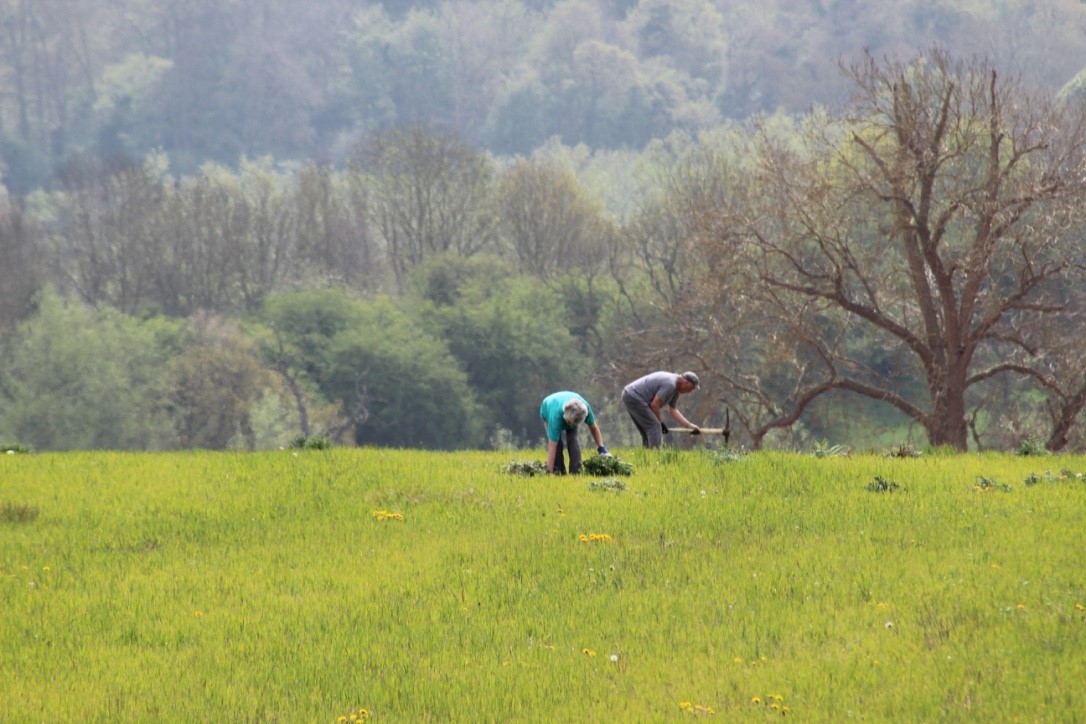By Guy Parker, Wychwood Biodiversity
Now winter is drawing in it’s a good time to reflect on land management at Southill and what we’ve collectively managed to achieve this year.
Southill is a community project and the land management has benefitted from the ideas, expertise and elbow grease of a large number of people in this past year. On behalf of Southill, thank you to all for your hard work to date. I’m looking forward to seeing the wildlife habitats really starting to flourish in 2018.
Planting the orchard of fruit trees
The year started with the planting of a wonderful orchard of 60 fruit trees including 30 traditional varieties of apple, pear and nut carefully selected by Christine Elliott. A big crowd of volunteers turned out to help with planting on a blustery January morning, with Christine and 2 horticulturalists from Nicholsons leading the charge. The fruit trees will be managed by Christine as a community orchard, with plenty of windfalls being left for wildlife too.
Digging out perennial weeds in April
Filling the hedge gaps on the boundary
In the same morning, we planted small clumps of hawthorn, crab apple and field maple along the road boundary which will grow up into short, dense trees that fill the hedge gaps and provide great habitat for birds.
Creating new grassland habitat
Our plans to create new grassland habitat were thwarted by a very dry spring. However, the rain returned in late May and we were able to start seeding.
First, we seeded the margins of the entire site with a broad strip of tussocky grassland and wild flowers. This mix got off to a slow start in the dry conditions, but some heavy summer rainfall and a mild Autumn has helped them catch up. This habitat should provide a lovely floral display through future summers and will provide great foraging for birds and insects.
Field margins, newly seeded with tussock grassland and wild flowers
Nesting skylarks and other birds on the site
Southill’s unique design means only the lower half of the site (nearest the railway) is covered in solar panels, and the entire upper half of the site (nearest the road) has been set aside for wildlife. One of the delights of this past year has been watching the skylarks displaying and foraging for their young in this upper area.
Thanks to Louise and Alan Spicer, and to Bird Aid (part of the Wychwood Project), we have for the past 2 years hired a bird specialist, Tony Powell, to undertake a breeding bird survey through the spring and summer. His survey last year revealed 6 pairs of nesting skylarks and a similar number appear to be nesting here again this year, following the installation of the panels. Further, there were 48 species of bird observed overall – a surprisingly high number, and something we aim to build upon.
We seeded the bottom of the south field (next to Fawler mill) with a wild bird seed mix which will help feed the resident yellowhammers and linnets through the sparse winter months. This bird seed mix has done very well on the deeper soils and the quinoa and kale crops are now heavy with seeds.
Spreading the green hay cut from the meadow (background) in early August
Sowing our wildflower meadow
In late summer, we sowed a wild flower meadow on the upper half of the site. In order to minimise disturbance to the skylarks, meadow seed was sown on the southern field, but the northern field was left fallow so the skylarks can breed there undisturbed next spring. We selected a wild flower mix that was formulated especially for the local limestone soils.
All the seeds used on site have been provided by Costwold Seeds, a local seed merchant, and sown by Rob Hobhill and his team from Ditchley.
We inherited a small wild flower meadow at the very north of the site which is estimated to be at least 20 years old, and every summer is abuzz with bumblebees and butterflies feeding on the wild marjoram and St John’s wort. In August we took a cut of green hay and used it to seed a small area of neighbouring bare soil.
The idea with green hay is you cut the grasses and wild flowers in late summer (once their seeds have set), then spread them on a newly cultivated site. The seeds then fall off their stalks onto the bare soil where they germinate the following spring. We hope to repeat this process year-on-year, to spread the flowers from our meadow across much of the northern part of the site.
Pulling ragwort from the meadow in July
Weeds, weeds, weeds...and community power
As many of you know first hand, we’ve had a real battle with weeds across the site as we’ve started the transition from farming to wildlife management. Thanks to so many of you for pitching in repeatedly over the spring and summer, starting with a hugely successful digging out of perennial thistles and then later in the year, hand pulling many hundreds of ragwort plants from the site. A special thanks to Anne Miller, who has been the driving force behind these weed-busting missions.
Guy Parker, Wychwood Biodiversity






